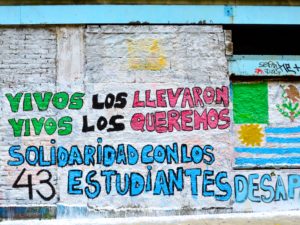Ayotzinapa Remains Fresh in Mexican Minds
 “¡Vivos se los llevaron!¡Vivos los queremos!” Thousands chanted these words in Mexico City on September 26, calling for the return of the forty-three Ayotzinapa students who disappeared two years ago in the southern state of Guerrero. According to Excélsior, thousands marched from the Angel of Independence monument toward the Zócalo, or Constitution Square, in commemoration of one of the most controversial human rights cases to shake Mexico.
“¡Vivos se los llevaron!¡Vivos los queremos!” Thousands chanted these words in Mexico City on September 26, calling for the return of the forty-three Ayotzinapa students who disappeared two years ago in the southern state of Guerrero. According to Excélsior, thousands marched from the Angel of Independence monument toward the Zócalo, or Constitution Square, in commemoration of one of the most controversial human rights cases to shake Mexico.
Between the evening of September 26, 2014 and the morning of September 27, 2014, students from the Ayotzinapa Rural Teachers’ College disappeared while participating in a caravan to Mexico City. The New York Times published an article this past April recounting the horrific events that allegedly transpired at the hands of Mexican authorities. Testimonies and videos prove that federal authorities were present at the crime; however, two years later, the students’ whereabouts are still unknown.
In January 2015, the Office of the Attorney General in Mexico, or the “PGR” by its Spanish acronym, released a report on the conclusions of their investigations, stating that the students’ bodies were incinerated and that the remains were thrown in a river.
In response to complaints made by Mexican civil society, the Organization of American States appointed the Interdisciplinary Group of Independent Experts, or “GIEI” by its Spanish acronym, to provide “technical assistance to the investigation of the forced disappearance” of the students and to “provide recommendations” to the State of Mexico regarding forced disappearances. Evidence found by the GIEI directly contradicts official reports, raising questions about impunity and corruption in domestic investigations.
President Peña Nieto has also been accused of ignoring the calls for justice made by the families of the victims and by both national and international civil society. He received backlash after his visit to Guerrero in December 2014, when, according to La Jornada, he urged citizens to “overcome this period” and to “take a step forward.”
With the goal of appeasing the Mexican public, Peña Nieto’s words have done nothing of the sort. In addition to criticism regarding the handling of the case, the president faces other accusations of corruption and negligence that have driven his approval ratings to an all-time low of twenty-three percent, as reported by Reuters and Grupo Reforma this past August.
As a result of its current state of affairs, the country received a low ranking in the World Justice Project’s 2015 Rule of Law Index. Mexico has also come under fire in recent months for its lack of security for journalists, according to press releases by the Special Rapporteur on Freedom of Expression from the Inter-American Commission on Human Rights.
El País reported that Jan Jarab, the UN High Commissioner for Human Rights’ representative in Mexico, spoke out on September 21 about the impunity and lack of clarity surrounding the Ayotzinapa case.. This gained much attention, as his visit to Ayotzinapa came a day after President Peña Nieto’s address to the UN General Assembly, which failed to mention the high-profile case.
The fact that not much has changed in terms of state and civil relations since 2014 lies at the heart of this year’s commemoration of the massacre. Just this past June, police and protesters clashed in the state of Oaxaca, leaving eight dead, including a journalist, and dozens injured, according to CNN. With various incidents of drug violence in southern Mexico, faith in Mexican authorities remains extremely low. As seen in this week’s marches throughout Mexico, there are clear signs of frustration concerning the Mexican government and the country’s political apparatus, with few signs for future improvement.
